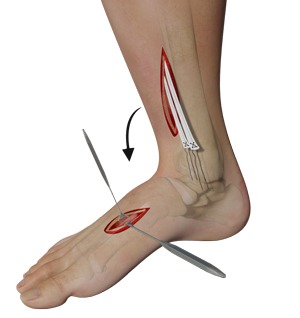
Foot Anatomy and Movement
The foot and ankle are a complex joint involved in movement and providing stability and balance to the body. The foot and ankle consist of 26 bones, 33 joints, and many muscles, tendons, and ligaments. Damage to the soft tissues such as nerves and muscles of the foot can cause weakness, decreased movement and difficulty in standing, walking and even wearing shoes.
What is a Tendon Transfer?
In a tendon transfer procedure, a healthy tendon is transferred to replace the damaged tendon and restore the normal movement of the foot.
Indications of Tendon Transfer
Tendon transfer surgery is indicated for the following conditions:
Flexible flatfoot: The arch of the foot collapses because of the stretching or rupture of the posterior tibial tendon (attaches the calf muscle to the bones on the inside of the foot), leading to pain and discomfort. You tend to walk on the inside of the foot as your foot rolls outward.
Neurological problem: Charcot-Marie-Tooth disease, nerve damage after an accident or surgery or weakness following a stroke can weaken the muscles of the foot causing pain and fractures. You tend to walk on the outside of the foot as your foot rolls inward.
There are three prerequisites for the surgery to be successful:
- The muscle attached to the tendon should be functional.
- The soft tissue that will receive the tendon should be functional. Scarring or skin damage makes the process of transfer difficult.
- The joints through which the tendon will pass should be mobile and stable.
Tendon Transfer Procedure
Tendon transfer surgery is usually performed under general anesthesia. An incision is made along the foot and the damaged tendon is exposed and removed. A healthy tendon is identified, cut at its normal insertion, rerouted through the soft tissues and bones, and then sutured to another bone in the foot. A tunnel may be drilled to allow the tendon to pass through and then sewn on itself, fastened with a metal or plastic screw, or attached with anchor sutures. The soft tissues and incision are closed, and your foot will be placed in a splint.
What to Expect After Tendon Transfer Care
You will be non-weight bearing for 6 weeks after surgery to allow the tendon to heal. Your splint will remain for 10 to 14 days. Once it is removed, a cast or surgical boot will be placed and removed 12 weeks after surgery. You will be introduced to physical therapy shortly to strengthen your muscles and help you ambulate.
Complications of Tendon Transfer
As with all surgeries, tendon transfer surgery may be associated with certain complications such as
- Infection
- Anesthesia-related risks
- Bleeding
- Clot formation
- Damage to adjacent blood vessels and nerves
- Non-healing, rupture or loosening of the tendon
- Progression of the primary neurological condition
- Need for further surgery







